Determining the viscosity-temperature curve and the required preheating temperature
Prescribed injection viscosity
in mm²/s
Required temperature of heavy fuel oil
at engine inlet
1)
in °C
≥ 12 126 (line c)
≤ 14 119 (line d)
1)
With these figures, the temperature drop between the last preheating device and
the fuel injection pump is not taken into account.
Table 1: Determining the viscosity-temperature curve and the required preheating
temperature
A heavy fuel oil with a viscosity of 180 mm
2
/s at 50 °C can reach a viscosity
of 1,000 mm
2
/s at 24 °C (line e) – this is the maximum permissible viscosity
of fuel that the pump can deliver.
A heavy fuel oil discharge temperature of 152 °C is reached when using a
recent state-of-the-art preheating device with 8 bar saturated steam. At
higher temperatures there is a risk of residues forming in the preheating sys-
tem – this leads to a reduction in heating output and thermal overloading of
the heavy fuel oil. Asphalt is also formed in this case, i.e. quality deterioration.
The heavy fuel oil lines between the outlet of the last preheating system and
the injection valve must be suitably insulated to limit the maximum drop in
temperature to 4 °C. This is the only way to achieve the necessary injection
viscosity of 14 mm
2
/s for heavy fuel oils with a reference viscosity of 700
mm
2
/s at 50 °C (the maximum viscosity as defined in the international specifi-
cations such as ISO CIMAC or British Standard). If heavy fuel oil with a low
reference viscosity is used, the injection viscosity should ideally be 12 mm
2
/s
in order to achieve more effective atomisation to reduce the combustion resi-
due.
The delivery pump must be designed for heavy fuel oil with a viscosity of up
to 1,000 mm
2
/s. The pour point also determines whether the pump is capa-
ble of transporting the heavy fuel oil. The bunker facility must be designed so
as to allow the heavy fuel oil to be heated to roughly 10 °C above the pour
point.
Viscosity
The viscosity of gas oil or diesel oil (marine diesel oil) upstream of the
engine must be at least 1.9 mm
2
/s. If the viscosity is too low, this may
cause seizing of the pump plunger or nozzle needle valves as a result
of insufficient lubrication.
This can be avoided by monitoring the temperature of the fuel. Although the
maximum permissible temperature depends on the viscosity of the fuel, it
must never exceed the following values:
▪ 45 °C at the most with MGO (DMA) and MDO (DMB)
A fuel cooler must therefore be installed.
If the viscosity of the fuel is < 2 cSt at 40 °C, consult the technical service of
MAN Diesel & Turbo in Augsburg.
Example: Heavy fuel oil with
180 mm²/s at 50 °C
Viscosity-temperature diagram (VT diagram)
D010.000.023-06-0001
General
2016-09-26 - de
010.000.023-06
MAN Diesel & Turbo
2 (2) D010.000.023-06-0001 EN

